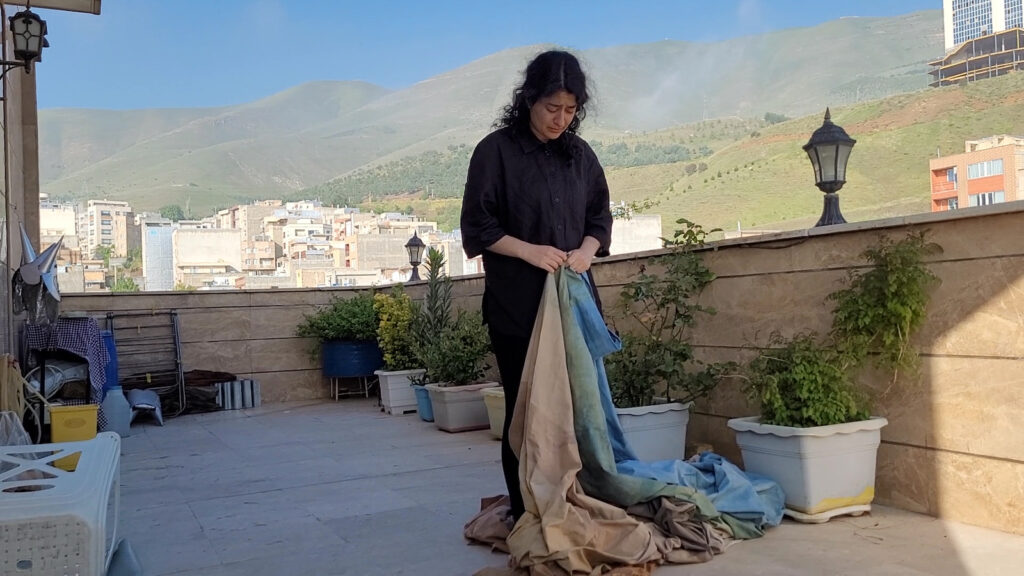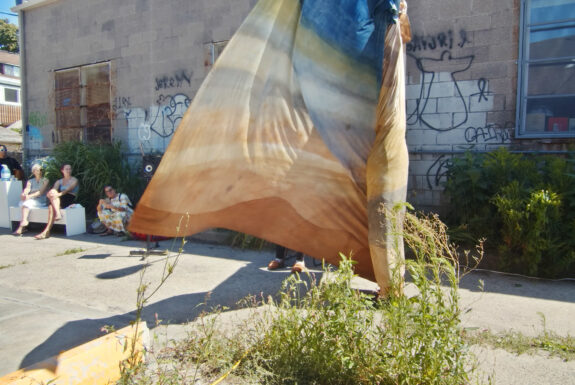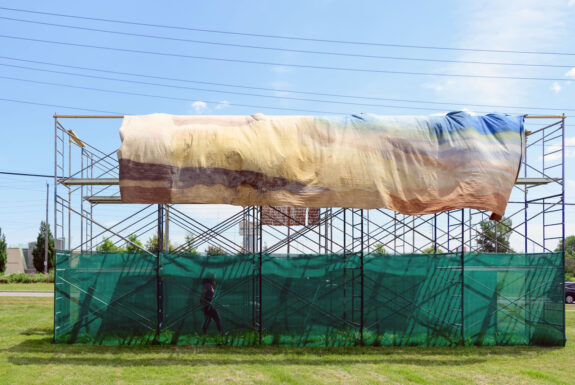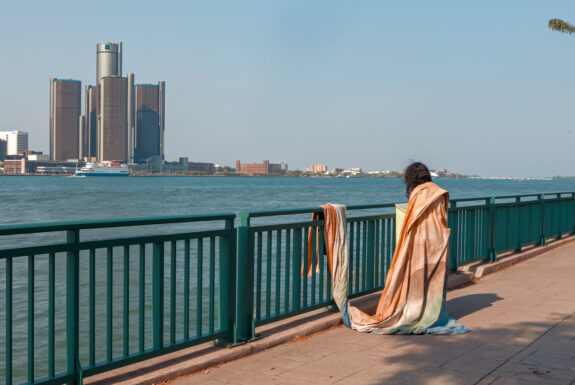KAMGARI, Abedar
Canada

Abedar Kamgari, Cavity 2024 VIDEO STILL
Cavity
Site-specific performance
(in dialogue with Bojana Videkanic’s Skin)
Launched July 24, 2024
Two years ago, I returned to my birth country and spent a few months in my grandparents’ home city. I was thinking about border spaces and relationships to land, and exploring curtains and doors as manifestations of distance. While I was there, I collected food scraps from what we were eating and foraged plants on my walks around town and travels along the western border. Extracting natural dyes from these materials, I coloured a large piece of fabric on my grandparents’ balcony in the middle of winter.
This process was a way for me to think about how to remember. I hoped that the gathering and dyeing process of the fabric curtain would serve as a visual diary or map, to help me remember my interactions with the people and places that populated my world at the time of its making. As a diasporic person, I rarely see relatives with whom to reminisce about shared memories or history, and I worry this distance renders remembering more challenging. While the finished object did not activate my recollection of events in the ways I initially assumed, I developed a form of body memory through the labour-intensive process of creating it. My muscles learned to perform certain tasks, sometimes with great repetition. My hands now carry a knowledge outside of language. Perhaps I cannot recall who was present or what was said when I worked with a particular colour, but my body remembers how I brushed indigo.
Significantly, through this endeavor, my family became curious and involved in my work. The aunties would peek at what I was up to on the balcony—or perhaps at the big mess I created. My grandfather would speculate as to why I did not choose to study law. But perhaps most importantly, my sweet, loving grandmother would roll up her sleeves and get involved without my ever asking, to help make sure the fabric dried properly between colours (an endless task) or was carefully folded when I was getting ready to leave. I activated the fabric curtain we made together in a series of performances and site-responsive explorations upon returning to Canada.
My grandma, a teacher by trade and by heart, taught me her own body memory from her youth—when women would sit around and spin wool. Many women at that time earned their livelihoods from weaving rugs and kilims, and these practices were considered every day in many working class urban and rural homes. Despite the fact that she had not practiced these skills in years, her hands quickly remembered what to do of their own accord.
I had been researching in 7a*11d’s extensive archive for themes of borders, inheritances, intergenerational relations, and trauma. I began with Ali Al-Fatlawi and Wathiq Al-Ameri’s layered performance Vanishing Borders (2014). From there, I watched performances that used white powders such as chalk or flour, which led me to works by Fausto Méndez Luna, Christian Messier, József R. Juhász, and Bojana Videkanic. I was interested in these charged materials for their potential to communicate everyday violence. I was thinking of large public gestures. I was very much thinking with my head. At the same time, I was developing a curatorial project exploring personal and collective manifestations of grief as we witness and lament unfolding genocides, destruction of the climate, ongoing pandemic, and the rise of global fascism.
Yet when my grandmother died suddenly, the ground shifted beneath my feet. I went from a somewhat distanced experience of grief into a raw and deeply personal one. Of course, the two have informed each other. I had already been thinking about shrouds, about what death can tell us about the value of a life. I had already been thinking closely with Videkanic’s affective performance, Skin (2010), where her use of dough evokes a deep sense of loss, yearning, quiet determination, and of flesh, tombs, and wombs. When I arrived back home for my grandma’s burial, I felt a responsibility not to avert my eyes from death, to resist its romanticization in light of the concurrent, systemic mass murder of Palestinians in Gaza, and of all oppressed peoples everywhere.
My body craved ceremony. Yet the usual rituals and large gatherings seemed absurd and insufficient. I wanted to be with plants. I wanted to be with the freshwater springs, the earth. I wanted to bury my grandmother in the fabric curtain she helped me make. But this was not permitted. I needed to figure out who I was without her, what this piece of fabric now meant. Is death another moment of dispersal, another diaspora? How do we carry pieces of each other? Who do we become in our witnessing, in the absence? On the same balcony where it was created, among my grandmother’s thriving flowers and outdoor slippers, I made another performance with our curtain. A performance just for me. For the birds. For the wind. For a memory. A performance for making sense of all this loss, the personal and the global.
For holding on and letting go.
Abedar Kamgari is an artist, curator, and arts worker based in Hamilton and Toronto. In her practice, Abedar considers contexts and conditions of displacement and diaspora. She often engages performative, site-responsive, and participatory strategies to unpack the presence, absence, movements, and responsibilities of bodies in relation to land and labour. She is interested in body memory, complicated inheritances, border spaces, and the idea of distance. Abedar holds a BFA (2016) and an MFA (2022) in interdisciplinary studio, and has performed, screened, and exhibited her work in a range of institutions across Southern Ontario.
References/Resources
This is now a strange scene; to be at a funeral and see a shroud, inside which is a whole body with two hands, ten fingers, two feet, and a head. Nowadays, we Gazans are lucky if we even get to have a funeral, to bury an intact body, or to have our family and friends there to say goodbye and cry over us.
A passage from Mariam Mohammad Al-Khateeb’s letter The Luxury of Death (2024)
The following references were cited by Abedar Kamgari in her TPAC interview.
From the TPAC public web archive:
Fausto Méndez Luna’s Cocina incoherente [Incoherent cuisine] (2014)
Ali Al-Fatlawi and Wathiq Al-Ameri’s Vanishing Borders (2014)
Bojana Videkanic’s Skin (2010)
Other artist references:
Chun Hua Catherine Dong’s I have been there (2017-ongoing)
Forough Farrokhzad’s Someone Who is Not Like Anyone (1966)
Grace Ndiritu’s The Nightingale (2003)
Abedar Kamgari, Cavity site-specific performance. Commissioned for Toronto Performance Art Collective's 7a*mgr8 series. © Abedar Kamgari 2024.
Abedar Kamgari interviewed by Paul Couillard ©Toronto Performance Art Collective, Abedar Kamgari, 2024




